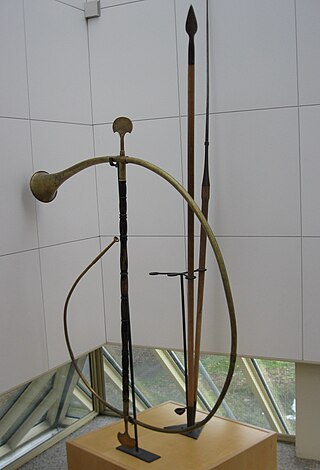Libitina, also Libentina or Lubentina, is an ancient Roman goddess of funerals and burial. Her name was used as a metonymy for death, and undertakers were known as libitinarii. Libitina was associated with Venus, and the name appears in some authors as an epithet of Venus.

Ambarvalia was a Roman agricultural fertility rite held on 29 May in honor of Ceres and Dea Dia.

Religion in ancient Rome consisted of varying imperial and provincial religious practices, which were followed both by the people of Rome as well as those who were brought under its rule.

Festivals in ancient Rome were a very important part in Roman religious life during both the Republican and Imperial eras, and one of the primary features of the Roman calendar. Feriae were either public (publicae) or private (privatae). State holidays were celebrated by the Roman people and received public funding. Games (ludi), such as the Ludi Apollinares, were not technically feriae, but the days on which they were celebrated were dies festi, holidays in the modern sense of days off work. Although feriae were paid for by the state, ludi were often funded by wealthy individuals. Feriae privatae were holidays celebrated in honor of private individuals or by families. This article deals only with public holidays, including rites celebrated by the state priests of Rome at temples, as well as celebrations by neighborhoods, families, and friends held simultaneously throughout Rome.

In ancient Roman religion, the rex sacrorum was a senatorial priesthood reserved for patricians. Although in the historical era, the pontifex maximus was the head of Roman state religion, Festus says that in the ranking of the highest Roman priests, the rex sacrorum was of highest prestige, followed by the flamines maiores and the pontifex maximus. The rex sacrorum was based in the Regia.

A flamen was a priest of the ancient Roman religion who was assigned to one of eighteen deities with official cults during the Roman Republic. The most important of these were the three flamines maiores, who served the important Roman gods Jupiter, Mars, and Quirinus. The remaining twelve were the flamines minores. Two of the minores served deities whose names are now unknown; among the others are deities about whom little is known other than the name. During the Imperial era, the cult of a deified emperor also had a flamen.

In ancient Roman religion and mythology, Tellus Mater or Terra Mater is the personification of the Earth. Although Tellus and Terra are hardly distinguishable during the Imperial era, Tellus was the name of the original earth goddess in the religious practices of the Republic or earlier. The scholar Varro (1st century BC) lists Tellus as one of the di selecti, the twenty principal gods of Rome, and one of the twelve agricultural deities. She is regularly associated with Ceres in rituals pertaining to the earth and agricultural fertility.

Februarius, fully Mensis Februarius, was the shortest month of the Roman calendar from which the Julian and Gregorian month of February derived. It was eventually placed second in order, preceded by Ianuarius and followed by Martius. In the oldest Roman calendar, which the Romans believed to have been instituted by their legendary founder Romulus, March was the first month, and the calendar year had only ten months in all. Ianuarius and Februarius were supposed to have been added by Numa Pompilius, the second king of Rome, originally at the end of the year. It is unclear when the Romans reset the course of the year so that January and February came first.
In ancient Roman religion, the Armilustrium was a festival in honor of Mars, the god of war, celebrated on October 19. On this day the weapons of the soldiers were ritually purified and stored for winter. The army would be assembled and reviewed in the Circus Maximus, garlanded with flowers. The trumpets (tubae) would be played as part of the purification rites. The Romans gathered with their arms and armour on the Aventine Hill, and held a procession with torches and sacrificial animals. The dancing priests of Mars known as the Salii may also have taken part in the ceremony.

In ancient Roman religion, a lūcus is a sacred grove.

The Equirria were two ancient Roman festivals of chariot racing, or perhaps horseback racing, held in honor of the god Mars, one 27 February and the other 14 March.

In Ancient Rome the month of March was the traditional start of the campaign season, and the Tubilustrium was a ceremony to make the army fit for war. The ceremony involved sacred trumpets called tubae.

Vulcan is the god of fire including the fire of volcanoes, deserts, metalworking and the forge in Sabine and ancient Roman religion and myth. He is often depicted with a blacksmith's hammer. The Vulcanalia was the annual festival held August 23 in his honor. His Greek counterpart is Hephaestus, the god of fire and smithery. In Etruscan religion, he is identified with Sethlans.

Maius or mensis Maius (May) was the third month of the ancient Roman calendar, following Aprilis (April) and preceding Iunius (June). On the oldest Roman calendar that had begun with March, it was the third of ten months in the year. May had 31 days.

In ancient Roman religion, sacra were transactions relating to the worship of the gods, especially sacrifice and prayer. They are either sacra privata or publica. The former were undertaken on behalf of the individual by himself, on behalf of the family by the pater familias, or on behalf of the gens by the whole body of the people.

The vocabulary of ancient Roman religion was highly specialized. Its study affords important information about the religion, traditions and beliefs of the ancient Romans. This legacy is conspicuous in European cultural history in its influence on later juridical and religious vocabulary in Europe, particularly of the Christian Church. This glossary provides explanations of concepts as they were expressed in Latin pertaining to religious practices and beliefs, with links to articles on major topics such as priesthoods, forms of divination, and rituals.
In ancient Roman religion, the Fordicidia was a festival of fertility, held on the Ides of April, that pertained to farming and animal husbandry. It involved the sacrifice of a pregnant cow to Tellus, the ancient Roman goddess of the Earth, in proximity to the festival of Ceres (Cerealia) on April 19.

In ancient Roman religion, the October Horse was an animal sacrifice to Mars carried out on October 15, coinciding with the end of the agricultural and military campaigning season. The rite took place during one of three horse-racing festivals held in honor of Mars, the others being the two Equirria on February 27 and March 14.

In ancient Roman religion, the Mamuralia or Sacrum Mamurio was a festival held on March 14 or 15, named only in sources from late antiquity. According to Joannes Lydus, an old man wearing animal skins was beaten ritually with sticks. The name is connected to Mamurius Veturius, who according to tradition was the craftsman who made the ritual shields (ancilia) that hung in the temple of Mars. Because the Roman calendar originally began in March, the Sacrum Mamurio is usually regarded as a ritual marking the transition from the old year to the new. It shares some characteristics with scapegoat or pharmakos ritual.

The supplicia canum was an annual sacrifice of ancient Roman religion in which live dogs were suspended from a furca ("fork") or cross (crux) and paraded. It appears on none of the extant Roman calendars, but a late source places it on August 3 (III Non. Aug.).












